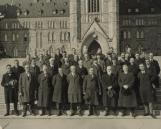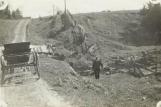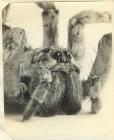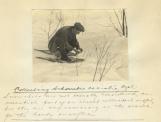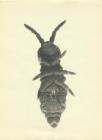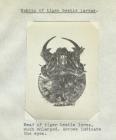2
The previous photograph shows Macnamara (front row, extreme right) with his colleagues at a meeting of the Entomological Society of Ontario in November 1923. Charles studied Entomology by correspondence with Cornell University in the United States. He compiled a notebook of Scientific Observations between 1911- 1921. After retirement, Macnamara compiled 3 Scientific Scrapbooks between 1940 and 1944. Many studies of insects are documented in these books containing hundreds of small photographs and detailed observations.4
Charles Macnamara began photographing insects such as house flies and ants in 1909. At this time in his life, Macnamara was also heavily involved with the pictorial movement in photography. So while he was out capturing scenes such as "Hut in the Woods" and the "Dochert Creek" he was also searching the ground for ant roads.6
Taken from Charles Macnamara's Scientific Scrap Book No. 1, this stunning photograph of a female wolf spider was taken in 1916. Macnamara published this photograph in Canadian Entomologist magazine. Notes in this scientific scrap book do not indicate if Charles was pleased with this image. Instead, they record identification, observation and methodology:"The face of a female Wolf Spider, indentified (sic) by the late J.H. Emerton, leading authority on American spiders as Lycosa cinerea. A spider has no neck and cannot turn its head without turning its whole body, but with its eight eyes it can see pretty well all around when at rest. I dug this spider out of the burrow of a wasp in the sand, where the wasp, after paralysing but not killing it by a sting, had stored it for food for the wasp grub when it hatched from the egg deposited nearby. When I found the spider it was alive but could not move, so I was able to pose it for its portrait. It is enlarged here about 25 diameters."
8
Macnamara comments that "Snowshoes are not usually considered an essential part of an insect collector's outfit but they are very necessary in the search for the hardy snowflea.... Some 40 species have been recorded on the snow at one time or another, but by far the commonest snow-frequenter in this country is Achorutes socialis Uzel, a blue black insect about 2 mm.(say about 1/12 inch) when full grown. If you see tiny black specs jumping around on the snow in soft weather, they are almost sure to be insects of this species."10
A page from Charles Macnamara's Scientific Scrap Book No. 1 showing Springtail eggs, legs, jaws and a newly hatched Achorutes.12
Using a microscope allowed Macnamara to photograph tiny insects such as this Collembola. In August 1920, Macnamara described his discovery of a new species of Pseudachorutes (Collembola) in the limestone cups along the shore of Lac des Chats, in Canadian Entomologist magazine:" What concerns us here, however, is that these water-filled rock cups are great traps for some kinds of Collembola. Of course, the brisk, semi-acquatic Isotoma palustris Mull, which is at home on fresh-water shores all over the northern hemisphere, can leap nimbly in and out of the cups and play safely over the surface of the water. But any of the plodding Collembolan earth walkers that blunder into the little hollows find them snares for their feet, and once caught on the water film, few of them ever seem to reach the rocky side and safety again. So far I have collected nine different species and one variety of Collembola in the rock cups. Four species common elsewhere in the district, but six of them- and this is what makes the cups such an interesting hunting groung - I have never found anywhere else, and of these at least two are new to science."
14
Charles Macnamara was amused by the habits of the tiger beetle. He wrote an article for the Canadian Entomologist in November 1922 in which he described how to capture and study the habits of tiger beetle larvae. This article reveals that by this time in his life, Macnamara no longer looked to the landscape for artistic expression. He combines scientific detail with wit and humour when writing about the 'citizens' of Tiger Beetle Town."The Pilgrim in their Progress through the Interpreter's House were shown, among other excellent things in the Significant Rooms, "a man who could look no way but downwards" So busy was he with a muck-rake gathering together straws and sticks, that he never looked up to see an angel standing close by and holding out a crown for him. In spite of the moral of this story, when I want to find tiger beetle larvae I "look no way but downwards." Crowns, which have always been notoriously uneasy headgear, are much out of fashion at present. And if I did look up, I don't believe I would find an angel on the job anyway. So on my summer walks I usually keep my eyes fixed on every sandy path or bare, loamy place I come to, seeking the burrows of the tiger beetle grubs........ Last summer I found a collection of over 200 burrows in an area of about 10 feet by 20 feet on a sandy farm road in the Township of Fitzroy, County of Carleton, Ontario. This place I called "Tiger Beetle Town," and it was here that I principally studied the habits of the larvae."
